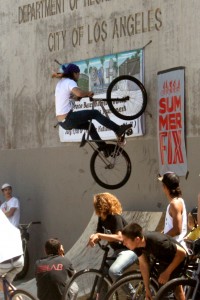 Summertime,
Summertime,
And the livin’ is easy
Fish are jumpin’
And the cotton is high…
Cotton may not be one of Utah’s hot commodities, but Ira Gershwin’s effusive lyrics express well the sentiment that floods much of the state at this time of year. Now that the Spring Queen is at hand, and the sun has finally peeked over the Rocky Mountains, it will be possible to go out for a bike ride without fear of wind chill. Truly, this is something to look forward to.
However, it should be acknowledged that even the blessed summer months come with their own set of dangers and inconveniences. What this season lacks in blizzards and stiff winds, it fully compensates for in other areas. Reading what these compensations are may temporarily kill your joy; but it’s all for the best to be informed. (After all, your joy can take the hit better than you can.)
1. Increased Traffic
Summertime is not only a time when many Utah natives are going on outings; it is also a time for the road to swarm with tourists and through traffic as people from outside the state take their own summer vacations in or around Utah’s borders. This means more cars on the road and more obstacles for bicyclists to watch out for. While many bicyclists may breathe a sigh of relief now that the snow and ice have melted, this relief may be misplaced. The fact is, in spite of the fair weather and absence of latent ice patches, the summer months are the most dangerous months to be on the road. It’s perfectly natural to be thrilled with the change in weather—just don’t let your exuberance overwhelm your good sense.
2. Extreme Brightness
While natural light is typically better for the eyes than fluorescent bulbs, the intense sunlight of Utah in the summertime can be literally blinding. Not only can prolonged exposure to this intense light lead to eye strain and/or diminished vision in the long run; the glare glancing off cars and buildings can be distracting and thus interfere with a bicyclist’s ability to connect visually with their surroundings. For a bicyclist, seeing and being seen are vital to staying safe on their commute. Circumstances that obstruct vision, whether they be haze or burning light, are always touch-and-go. If summer midday bicycling cannot be avoided, sunglasses and appropriate clothing are a must.
3. Dehydration
Every part of the body, from the feet on the pedals to the brain under the helmet, requires water to work properly. When the body is not hydrated, it can be more than merely uncomfortable, as the symptoms of dehydration include fatigue, headache, increased blood pressure, and general befuddlement. Fatigue and headaches are as dangerous for a bicyclist as for a motorist, if not more so—they will be less alert to roadway risks and less able to maneuver sharply. The bicyclist who is dehydrated to distraction may periodically lose sight of the street in front of them or miss oncoming menaces. When bicycling in the summertime, always keep a water bottle on hand.
4. Flash Flooding
In a dry state such as ours is, the ground is not accustomed to absorb large amounts of water quickly. Those freak summer cloudbursts that vomit buckets of water are more likely to overflow from the gutters and wash over streets at high speed than to soak docilely into the parched, unpaved earth. It should come as no surprise that torrents of water rushing down or across the road pose a hazard to bicyclists (and even drivers, to some extent), who cannot withstand the force of such a high volume of rushing water. During a flash flood, a bicycle is useless as a mode of transportation. No one should attempt to navigate one on two wheels.
Those hazards that are not the natural byproducts of nature or human limitations are not the cross of the injury victim to bear without question. When the injury is severe, Utah personal injury attorneys like Christensen & Hymas can see to it that the victims receive the fullest possible compensation to seek the right medical care. For more information on what a personal injury attorney does and when you should consider retaining bicycle injury attorney, call the office of Christensen & Hymas at (801) 506-0800.
Image courtesy of Keith Justin Gallagher
http://www.flickr.com/photos/keithgallagher/4811756744/
